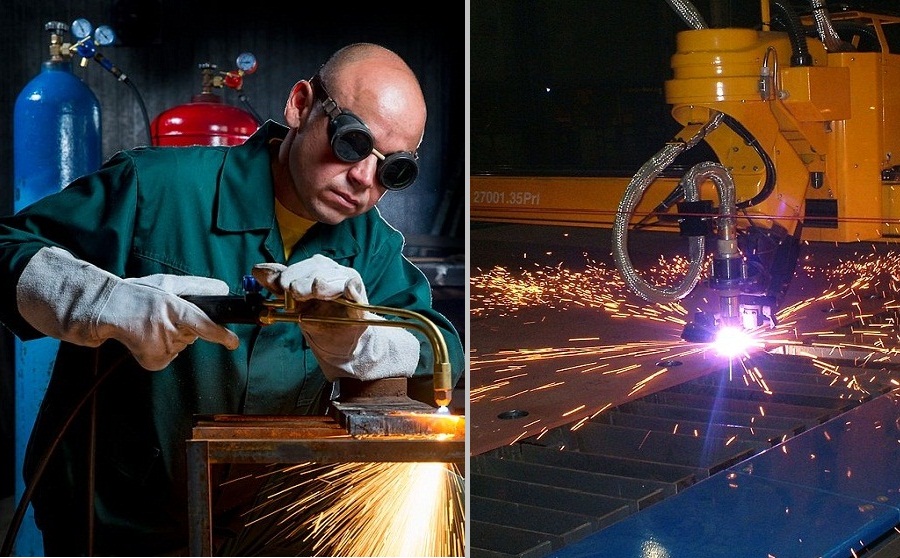If you’re a metalworker, then you might not be a stranger to popular processes - oxy-fuel and plasma cutting. Oxy-fuel torches and their purpose-built circle guide have been a long-time prominent choice for the construction industry. However, the evolving technology has now made plasma cutting systems a popular option for metalworkers.
On that account, there’s been a lot more confusion as to which process one should apply. This article will touch base on the advantages and disadvantages of oxy-fuel and plasma cutting systems to help gain a better understanding.
What Are Oxy-Fuel And Plasma Cutting?
Before we embark on the journey of pros and cons of both the system, let’s learn the basics about them.
Oxy-Fuel Cutting: It is a process in which the oxygen fuel gas flame preheats the material to its ignition temperature. After that, powerful oxygen is headed at the material to erect a chemical reaction between the oxygen and slag. Further, the oxygen jet depresses the pre-heated area from the plate’s bottom to complete the whole process.
Plasma Cutting: In this process, electricity is introduced into compressed air to produce an ironised, imbalanced plasma gas. Further, the pressurized air pushes the plasma gas through a small opening in the nozzle to produce controlled conductive steam of plasma gas. You can add more energy to improve the cutting process and efficiency of the system.
Pros And Cons Of Oxy-Fuel Cutting:
Pros:
- Best For Thicker Metals: On average, you can cut the steel of 6 to 12 inches thickness. In fact, some oxy-fuel cutting systems are also capable of cutting materials that are more than 20 inches thick. The oxy-fuel torches can cut with significant speed for cutting more than one-inch material, unlike 100-amp plasma cutting systems.
- A High Degree Of Probability: Since they need no electrical power, oxy-fuel systems provide a prominent possibility for cutting in the field. Additionally, some small systems that weigh up to 35 pounds can cut steel about anywhere with oxy-fuel tanks and a torch.
- Available In Extended Length: Typically, you can find the oxy-fuel torches in extended length on the market. It will aid to keep the operator at a distance from the heat, flames and slag generated during cutting. To cut materials into precise circles, you can find a gas circle guide for your torch.
- Versatile: The best among all, oxy-fuel cutting systems are handy, and their torches can cut, weld, braze, heat, solder and gauge.
Cons:
- Oxy-fuel cutting systems are widely known for cutting thicker materials; therefore, they cannot offer the benefits of cutting thinner materials.
- It takes time to cut materials.
- Oxy-fuel cutting systems require to enlarge safety at the job site as it requires proper handling of explosive gases or dealing with an open flame.
Pros And Cons Of Plasma Cutting Systems:
Pros:
- Can Cut Many Types Of Materials: Plasma cutters can cut non-ferrous metals like aluminium, stainless steel and cast iron in large volumes.
- Precise Cutting: Unlike oxy-fuel torches, narrow kerf in plasma cutting systems provides smooth cuts. Plasma circle guide also cuts circles and straight lines with ease and control. As well, it cuts quickly and with less slag.
- Doesn’t Require Preheating: Like an oxy-fuel cutting system, a plasma cutting system doesn’t need preheating before cutting. This way, you can conserve time and money.
- High Speed: As plasma can cut thread-like materials, it offers better performance and a higher pace when cutting stacked metals.
- Easy To Use: In comparison to oxy-fuel systems, plasma is simple to use and render you the benefit of minimum clean-up.
- It Is Safe: Last but not least, an oxy-fuel cutting system needs to deal with explosive gases. But the scenario is different in plasma, and thus it provides safety benefits too.
Cons:
- The main disadvantage of this system is its ineffectiveness for thick metals as well as ferrous metals.
- Plasma cutter doesn’t provide greater probability as oxy-fuel systems do.
- The initial outlay in plasma machines is quite costly than oxy-fuel cutting systems.
Decision Time!
It can be a tough decision to make between the cutting-edge technologies. However, understanding its fundamentals and pros and cons, as mentioned above, can help you decide what should you prefer for your business.
Ask yourself a few questions: What metal do I want to cut, and what will the thickest one? If you often need to cut thicker materials, then give the nod to the oxy-fuel cutting system. However, if precision is vital for you, then choose a plasma system.
Also read here to know how laser cutting works all different procedures explained.






